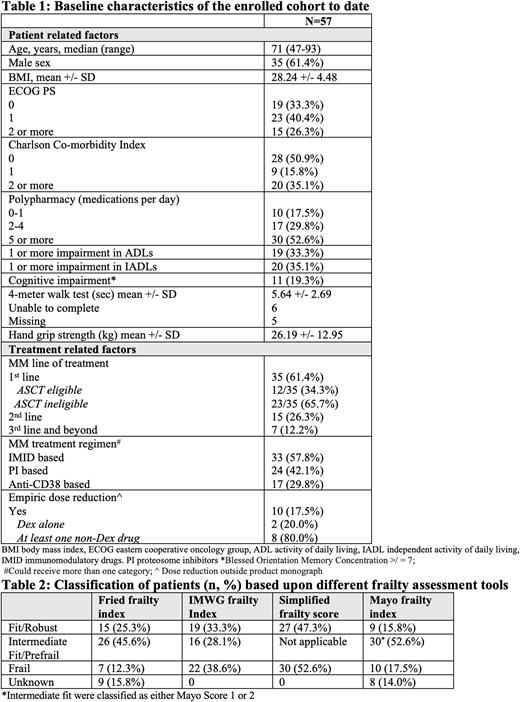Abstract
Introduction Multiple Myeloma (MM) is a non-curable cancer of older adults. Frailty has emerged as one important high-risk factor which confers a poor prognosis with reduced progression free survival, increased toxicity, higher rates of drug discontinuation and worse overall survival. Several tools have emerged for evaluation of frailty in MM in recent years. These include non-cancer specific geriatric assessment tools such as the Fried frailty index or more specific MM tools such as the International Myeloma Working Group (IMWG) frailty index, simplified frailty index or the Mayo frailty index. Uptake of these measures across clinical settings has been variable, leading to a gap in knowledge about the prevalence of geriatric impairments among MM patients as well as the proportion of patients classified as frail using these different scoring systems. The MFRAIL study is an ongoing prospective, multicentre study evaluating the association of different frailty assessment tools at baseline and longitudinally over time with clinical outcomes. In this abstract we present an interim analysis after at least 50% of patients have been enrolled. We describe baseline characteristics from the initial 57 patients enrolled into the study with the specific objective of 1) to report the prevalence of geriatric impairments among MM patients prior to therapy initiation 2) characterize the proportion of patients classified as frail using different frailty assessment tools.
Methods The MFRAIL is an ongoing, prospective pilot cohort study being conducted at three sites within Ontario, Canada which was initiated in August 2021. Multiple myeloma patients aged >18 initiating a new line of therapy are enrolled in the preceding six weeks. Demographic and MM-specific factors are collected at baseline and at 12 months following treatment along with MM response criteria, toxicity and health care utilization. Additional collected measures include: comorbidities, physical performance measures (NIH 4 meter walk test and grip strength), cognition, patient reported outcome of quality of life and depression. Frailty assessment tools measured include the IMWG frailty index (Palumbo et al. Blood 2015), simplified frailty index (Facon et al. Leukemia 2020), Mayo frailty index (Milani et al. AJH 2016) and the Fried frailty index (modified from Fried et al. J Gerontol A Biol Sci Med Sci 2001).
Results A total of 57 patients were enrolled in the study (data cut off June 1/2022) with baseline characteristics summarized in Table 1. The median age of the patients was 71 (range 47-93) with 61% males. A total of 26% and 35% of the patients had an ECOG and CCI status of 2 or higher, respectively. Polypharmacy was common with over 50% of the patients being prescribed five or more medications at baseline. Geriatric impairments were common with over 1/3 of the patients reporting at least one deficit in ADLs or IADLs. Additionally, cognitive impairment was present in 19.3% of the patients.
With regards to treatment details, 61.4% of the enrolled patients received first line treatment (ASCT eligible 34.3%, ASCT ineligible 65.7%), 26.3% second line and the remainder third line and beyond. Immunomodulatory-based treatments were the most common with 57.8% of the patients utilizing these agents. Empiric dose reduction outside the product monograph was observed in 17.5% of the patients with the majority of dose reductions (80%) done for agents other than dexamethasone alone among those patients.
The prevalence of frailty in our cohort ranged from 12.3% (Fried frailty index), 17.5% (Mayo frailty index), 38.6% (IMWG frailty index) to 52.6% (simplified frailty score). Similarly, the number of patients classified as fit/robust also varied ranging from 15.8% (Mayo frailty index), 25.3% (fried frailty index), 33.3% (IMWG frailty index) and 47.3% (simplified frailty score).
Conclusion Impairments in geriatric domain are common among real-world patients with MM emphasizing the need to incorporate these assessments in routine clinical practise. Additionally, prevalence of patients classified as frail versus fit varies depending upon the assessment tool utilized with no uniform definition of frailty in routine clinical practise. Further work is needed in both evaluating and standardizing frailty assessment tools in different clinical settings and with different therapeutic modalities to further optimize outcomes in this high-risk patient subgroup.
Disclosures
Mian:GSK, Janssen, BMS/Celgene, Forus therapeutics, Amgen, Takeda, Sanofi: Honoraria; Janssen: Research Funding. Louzada:Amgen: Honoraria; Celgene: Honoraria; Pfizer: Honoraria; Janssen: Honoraria. McCurdy:BMS: Honoraria, Research Funding; Janssen: Honoraria; Sanofi: Honoraria; Amgen: Honoraria; Takeda: Honoraria; GSK: Honoraria; Forus: Honoraria. Pond:Roche Canada: Current Employment, Other: Family member currently employed; Roche Ltd.: Other: Family member owns stock; Merck, Astra-Zeneca, Profound Medical: Consultancy; Takeda: Honoraria. Wildes:Janssen: Research Funding; Seattle Genetics: Membership on an entity's Board of Directors or advisory committees; Carevive, Sanofi: Consultancy.
Author notes
Asterisk with author names denotes non-ASH members.


This feature is available to Subscribers Only
Sign In or Create an Account Close Modal